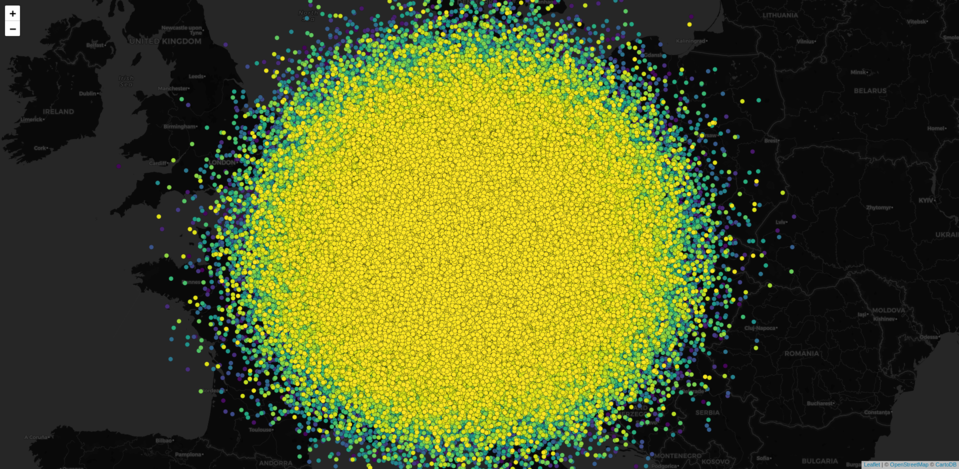An R package for fast web gl rendering of features on leaflet maps. It’s an R port of https://github.com/robertleeplummerjr/Leaflet.glify where more detailed information/documentation can be found. Also, if you like what you get here, make sure to star the original repo!
install.packages("leafgl")devtools::install_github("r-spatial/leafgl")It allows rendering of a large amount of features on a leaflet map. What exactly a “large amount” is, depends
- on the types of features and
- on the hardware/software of the rendering machine.
Regarding 1. millions of points should be no problem, but millions of polygons might, depending on their complexity - i.e. the number of vertices.
With regard to 2., obviously the amount of RAM will matter most but there are other, more suptle, problems that can occur.
Given it’s name, leafgl is intended to fully integrate with the leaflet
package, though it is very likely that it won’t be a 1:1 replacement for
the respective leaflet::add* functions. For example, given the
intention to render/visualise as many features as possible we need to
make a compromise on what additional information we allow to be part of
the rendering. So far, we allow coloring of features and popups based on
one column of the feature attributes, hence you cannot provide your own
popup content. This may seem drastic, but all this information is costly
both in terms of performance/speed and memory. In the end, who wants to
wait for a map that the browser isn’t able to render anyway…
For starters, it doesn’t guarantee to be working tomorrow. At this stage
leafgl is pre-alpha and under heavy development so things are likely
to change frequently. For example, we are thinking about shorter funtion
names (e.g. addGlPolygons instead of the current addGlifyPolygons).
Additionally, we are still figuring out which pathway is best to use in
order to pass data from R to the browser. As a result, rendering
environments other than the browser (or RStudio viewer) may not work
properly or at all until we approach a more stable implementation.
Depending on your operating system and browser, you may see some weird
colors that do not correspond to the ones that you specified. The only
known work-around at this stage is to set opacity = 1. For more
details the inclined reader is referred to this
issue
A lot! First and foremost you can use it as often as possible and report issues/bugreports and/or feature request (see end of page for details). If you have ideas on how to enhance functionality without impacting performance too much and feel confident enough to provide pull request, please don’t hesitate. Finally, if you have proficient knowledge of JavaScript and want/know how to improve the package in any way, we would very much love to hear from you!
This will render 1 Mio. points on a standard leaflet map.
library(leaflet)
library(leafgl)
library(sf)
n = 1e6
df1 = data.frame(id = 1:n,
x = rnorm(n, 10, 3),
y = rnorm(n, 49, 1.8))
pts = st_as_sf(df1, coords = c("x", "y"), crs = 4326)
options(viewer = NULL) # view in browser
leaflet() %>%
addProviderTiles(provider = providers$CartoDB.DarkMatter) %>%
addGlPoints(data = pts, group = "pts") %>%
setView(lng = 10.5, lat = 49.5, zoom = 6)For this we use library(colourvalues) because it can create color
voctors in the blink of an eye!
library(leaflet)
library(leafgl)
library(sf)
library(colourvalues)
n = 1e6
df1 = data.frame(id = 1:n,
x = rnorm(n, 10, 3),
y = rnorm(n, 49, 1.8))
pts = st_as_sf(df1, coords = c("x", "y"), crs = 4326)
cols = colour_values_rgb(pts$id, include_alpha = FALSE) / 255
leaflet() %>%
addProviderTiles(provider = providers$CartoDB.DarkMatter) %>%
addGlPoints(data = pts, fillColor = cols, group = "pts") %>%
setView(lng = 10.5, lat = 49.5, zoom = 6)In reality, it only 97112 polygons… But who wants to be pedantic here?
This data was downloaded from https://download.geofabrik.de/europe/switzerland.html
library(leaflet)
library(leafgl)
library(sf)
library(colourvalues)
ch_lu = st_read("/media/timpanse/d8346522-ef28-4d63-9bf3-19fec6e13aab/bu_lenovo/software/testing/mapview/switzerland/landuse.shp")
ch_lu = ch_lu[, c(1, 3, 4)] # don't handle NAs so far
options(viewer = NULL)
cols = colour_values_rgb(ch_lu$type, include_alpha = FALSE) / 255
leaflet() %>%
addProviderTiles(provider = providers$CartoDB.DarkMatter) %>%
addGlPolygons(data = ch_lu,
color = cols,
popup = "type",
group = "pols") %>%
setView(lng = 8.3, lat = 46.85, zoom = 9) %>%
addLayersControl(overlayGroups = "pols")Thanks to [@ColinFay](https://github.com/ColinFay) leafgl has
dedicated shiny functions. Given that what leafgl produces is a
leaflet map, we only need to use leafglOutput in our ui call. In
the server call we can simply use renderLeaflet. Here an example:
library(leaflet)
library(leafgl)
library(sf)
library(shiny)
n = 1e6
df1 = data.frame(id = 1:n,
x = rnorm(n, 10, 3),
y = rnorm(n, 49, 1.8))
pts = st_as_sf(df1, coords = c("x", "y"), crs = 4326)
options(viewer = NULL) # view in browser
m = leaflet() %>%
addProviderTiles(provider = providers$CartoDB.DarkMatter) %>%
addGlPoints(data = pts, group = "pts") %>%
setView(lng = 10.5, lat = 49.5, zoom = 4) %>%
addLayersControl(overlayGroups = "pts")
ui <- fluidPage(
leafglOutput("mymap")
)
server <- function(input, output, session) {
output$mymap <- renderLeaflet(m)
}
shinyApp(ui, server)Please file Pull requests, bug reports and feature requests at https://github.com/r-spatial/leafgl/issues


